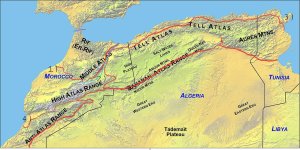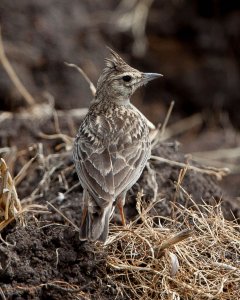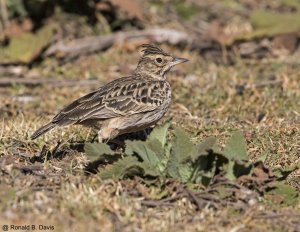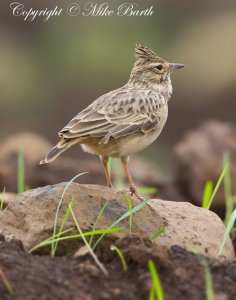
I was wondering how far we can get with these pictures.
Range descriptions from Galerida theklae (Thekla Lark) - Avibase or the newest Clements checklist.
Information extracted from Birds of the World by dint of Google:
1)
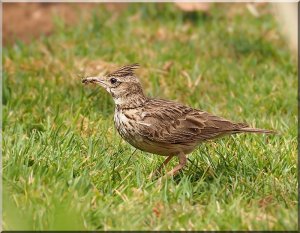
 www.birdforum.net
adult (= spring + worn plumage) erlangeri (the bill appears longish, which is supposedly a feature)
www.birdforum.net
adult (= spring + worn plumage) erlangeri (the bill appears longish, which is supposedly a feature)
2)
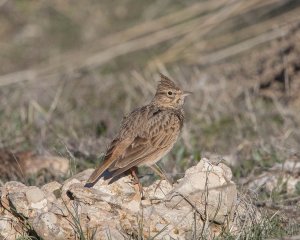
 www.birdforum.net
ruficolor
www.birdforum.net
ruficolor
3)
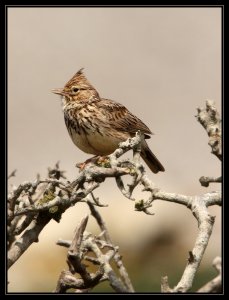
 www.birdforum.net
ruficolor
www.birdforum.net
ruficolor
4)
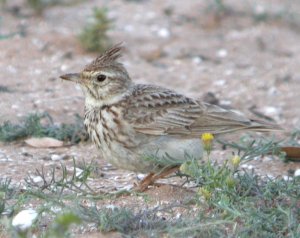
 www.birdforum.net
theresae/ruficolor
www.birdforum.net
theresae/ruficolor
Photos of birds from the same area:

 media.ebird.org
media.ebird.org
Photos of birds from ssp. ruficolor core range:

 media.ebird.org
media.ebird.org
Photos of birds from ssp. theresae core range:

 media.ebird.org
media.ebird.org
Below is a map made by me based on the latest Clements checklist, some other sources and speculation (the borders between the countries are off, but that's not my fault), containing numbers from 1-4.
@Acrocephalus
* * *
Range descriptions from Galerida theklae (Thekla Lark) - Avibase or the newest Clements checklist.
| erlangeri | N Morocco (e to Algerian border, s to Middle Atlas) |
| ruficolor | NE and c Morocco, coastal Algeria and n Tunisia |
| theresae | SW Morocco (s from Anti-Atlas Mts.) and Western Sahara |
| superflua | NE Morocco (w to Moulouya River) to n Algeria and Tunisia |
| carolinae | N Sahara (extreme e Morocco to ne Libya and extreme nw Egypt) |
* * *
Information extracted from Birds of the World by dint of Google:
Nominate race photo has whitish supercilium and eyering, dark eyestripe and moustachial and malar stripes; crown and upperparts grey-brown, heavily streaked blackish, more finely so on hindneck, rump plainer, uppertail-coverts rufous-tinged; flight-feathers dark olive-brown, narrowly edged buffish to light cinnamon; tail olive-brown to greyish centrally, remainder black, except for pale rufous outer feathers; whitish below, breast photo side and flanks strongly tinged buff, lower throat to breast and breast side with well-defined large blackish spots (usually merging to form heavy streaks); axillaries and underwing-coverts greyish; bill dark horn-brown, paler base of lower mandible; legs flesh-brown to yellowish-flesh. [...] Sexes similar. Juvenile video has shorter crest spotted upperparts, less intense chest streaking.
Races differ mainly in coloration and in intensity of streaking, also in size and bill size: erlangeri is darker than nominate, streaking above and below broadest and blackest, bill longer; ruficolor video is slightly paler than previous, feather edgings above more rufous, streaks below less intense; theresae resembles previous, but more rufous above, narrower streaks above and below; superflua is paler above, greyer or more sandy-coloured (variable), whiter below, upperparts and breast less streaked; carolinae is small and pale, light sandy to greyish with pinkish tinge above, plain or with minimal rufous streaking, mostly white below (sometimes pinkish wash), few scattered rufous-brown breast streaks, those in sandiest habitats often very pale and plain-looking (“deichleri”); praetermissa video is small and dark, heavily black-streaked above, buffish below, breast spots relatively small and indistinct; huei video is like previous but upperparts streaks heavier and blacker video; huriensis differs from previous in paler upperparts, more distinctly streaked crown, whiter throat, pinkish belly; ellioti resembles last, but upperparts paler and more sandy rufous; harrarensis is darker than previous, broader streaks above and on breast, bill smaller; mallablensis is much greyer, lacks warm tones, upperparts feathers edged whitish to greyish or cold buffish, rump and tail-coverts grey, breast with relatively heavy dark brown spots.
* * *
1)

Thekla Lark
use to read how this is so similar to the crested lark but got different calls, never knew that when i see it is will be able to recognize it easily. a lifer form Morocco. hope you like it, thanks for viewing.
*
2)

Thekla Lark
The Thekla Lark has a much shorter bill than yesterday's Crested Lark.
*
3)

Thekla Lark
*
4)

Thekla Lark
This trip has been the first one on which I have felt confident enough to claim Thekla Lark, but I am quite ready for someone out there to contradict me... In Morocco Thekla and Crested Larks are supposedly both very common (and both present in...
Photos of birds from the same area:
Thekla's Lark - Galerida theklae - Media Search - Macaulay Library and eBird
Explore millions of photos, audio recordings, and videos of birds and other animals; powered by Macaulay Library and eBird. The Macaulay Library collects, archives, and distributes wildlife media for research, education, and conservation.
Photos of birds from ssp. ruficolor core range:
Thekla's Lark - Galerida theklae - Media Search - Macaulay Library and eBird
Explore millions of photos, audio recordings, and videos of birds and other animals; powered by Macaulay Library and eBird. The Macaulay Library collects, archives, and distributes wildlife media for research, education, and conservation.
Photos of birds from ssp. theresae core range:
Thekla's Lark - Galerida theklae - Media Search - Macaulay Library and eBird
Explore millions of photos, audio recordings, and videos of birds and other animals; powered by Macaulay Library and eBird. The Macaulay Library collects, archives, and distributes wildlife media for research, education, and conservation.
* * *
Below is a map made by me based on the latest Clements checklist, some other sources and speculation (the borders between the countries are off, but that's not my fault), containing numbers from 1-4.
@Acrocephalus




